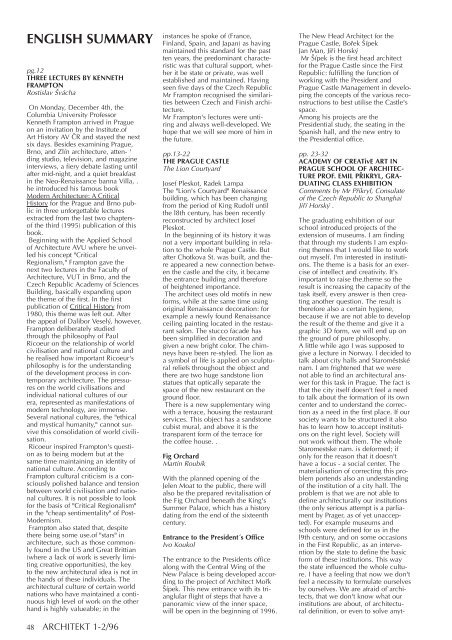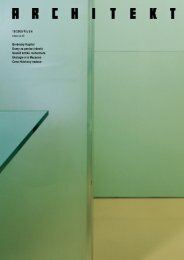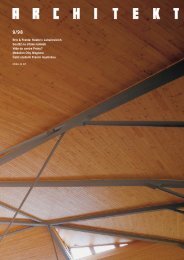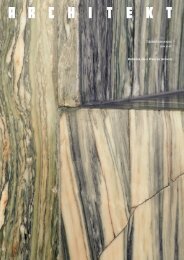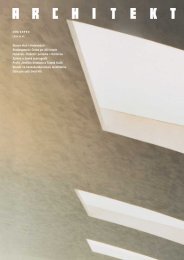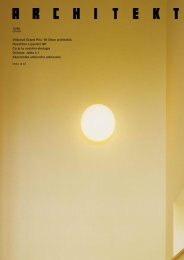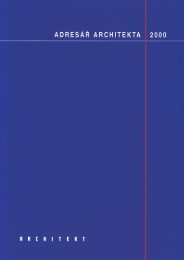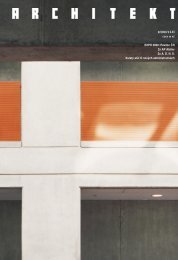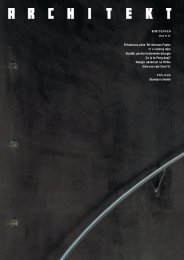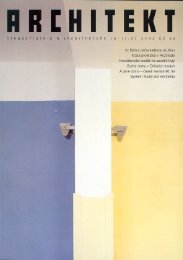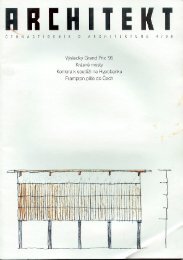Sen·to¯i ve ValdötejnskÃm pal·ci? - Tutorial.cz
Sen·to¯i ve ValdötejnskÃm pal·ci? - Tutorial.cz
Sen·to¯i ve ValdötejnskÃm pal·ci? - Tutorial.cz
You also want an ePaper? Increase the reach of your titles
YUMPU automatically turns print PDFs into web optimized ePapers that Google loves.
ENGLISH SUMMARYpg.12THREE LECTURES BY KENNETHFRAMPTONRostislav äv·chaOn Monday, December 4th, theColumbia Uni<strong>ve</strong>rsity ProfessorKenneth Frampton arri<strong>ve</strong>d in Pragueon an invitation by the Institute.ofArt History AV »R and stayed the nextsix days. Besides examining Prague,Brno, and ZlÌn architecture, atten- 'ding studio, television, and magazineinterviews, a fiery debate lasting untilafter mid-night, and a quiet breakfastin the Neo-Renaissance banna Villa, .he introduced his famous bookModern Architecture: A CriticalHistory for the Prague and Brno publicin three unforgettable lecturesextracted from the last two chaptersofthe third (1995) publication of thisbook.Beginning with the Applied Schoolof Architecture AVU where he un<strong>ve</strong>iledhis concept "CriticalRegionalism," Frampton ga<strong>ve</strong> thenext two lectures in the Faculty ofArchitecture, VUT in Brno, and theCzech Republic Academy of SciencesBuilding, basically expanding uponthe theme of the first. In the firstpublication of Critical History from1980, this theme was left out. Afterthe appeal of Dalibor Vesel˝, howe<strong>ve</strong>r,Frampton deliberately studiedthrough the philosophy of PaulRicoeur on the relationship of worldcivilisation and national culture andhe realised how important Ricoeur'sphilosophy is for the understandingof the de<strong>ve</strong>lopment process in contemporaryarchitecture. The pressureson the world civilisations andindividual national cultures of ourera, represented as manifestations ofmodern technology, are immense.Se<strong>ve</strong>ral national cultures, the "ethicaland mystical humanity," cannot survi<strong>ve</strong>this consolidation of world civilisation.Ricoeur inspired Frampton's questionas to being modern but at thesame time maintaining an identity ofnational culture. According toFrampton cultural criticism is a consciouslypolished balance and tensionbetween world civilisation and nationalcultures. It is not possible to lookfor the basis of "Critical Regionalism"in the "cheap sentimentality" of Post-Modernism.Frampton also stated that, despitethere being some use.of "stars" inarchitecture, such as those commonlyfound in the US and Great Brittian(where a lack of work is se<strong>ve</strong>rly limitingcreati<strong>ve</strong> opportunities), the keyto the new architectural idea is not inthe hands of these individuals. Thearchitectural culture of certain worldnations who ha<strong>ve</strong> maintained a continuoushigh le<strong>ve</strong>l of work on the otherhand is highly valueable; in the48 ARCHITEKT 1-2/96instances he spoke of (France,Finland, Spain, and Japan) as havingmaintained this standard for the pastten years, the predominant characteristicwas that cultural support, whetherit be state or private, was wellestablished and maintained. Havingseen fi<strong>ve</strong> days of the Czech RepublicMr Frampton recognised the similaritiesbetween Czech and Finish architecture.Mr Frampton's lectures were untiringand always well-de<strong>ve</strong>loped. Wehope that we will see more of him inthe future.pp.13-22THE PRAGUE CASTLEThe Lion CourtyardJosef Pleskot, Radek LampaThe "Lion's Courtyard" Renaissancebuilding, which has been changingfrom the period of King Rudolf untilthe l8th century, has been recentlyreconstructed by architect JosefPleskot.In the beginning of its history it wasnot a <strong>ve</strong>ry important building in relationto the whole Prague Castle. Butafter Chotkova St. was built, and thereappeared a new connection betweenthe castle and the city, it becamethe entrance building and thereforeof heightened importance.The architect uses old motifs in newforms, while at the same time usingoriginal Renaissance decoration: forexample a newly found Renaissanceceiling painting located in the restaurantsalon. The stucco facade hasbeen simplified in decoration andgi<strong>ve</strong>n a new bright color. The chimneysha<strong>ve</strong> been re-styled. The lion asa symbol of life is applied on sculpturalreliefs throughout the object andthere are two huge sandstone lionstatues that optically separate thespace of the new restaurant on theground floor.There is a new supplementary wingwith a terrace, housing the restaurantservices. This object has a sandstonecubist mural, and abo<strong>ve</strong> it is thetransparent form of the terrace forthe coffee house. .Fig OrchardMartin RoubÌkWith the planned opening of theJelen Moat to the public, there willalso be the prepared revitalisation ofthe Fig Orchard beneath the King'sSummer Palace, which has a historydating from the end of the sixteenthcentury.Entrance to the President¥s OfficeIvo KoukolThe entrance to the Presidents officealong with the Central Wing of theNew Palace is being de<strong>ve</strong>loped accordingto the project of Architect Mo¯käÌpek. This new entrance with its trianglularflight of steps that ha<strong>ve</strong> apanoramic view of the inner space,will be open in the beginning of 1996.The New Head Architect for thePrague Castle, Bo¯ek äÌpekJan Man, Ji¯i Horsk˝Mr äÌpek is the first head architectfor the Prague Castle since the FirstRepublic: fulfilling the function ofworking with the President andPrague Castle Management in de<strong>ve</strong>lopingthe concepts of the various reconstructionsto best utilise the Castle'sspace.Among his projects are thePresidential study, the seating in theSpanish hall, and the new entry tothe Presidential office.pp. 23-32ACADEMY OF CREATivE ART INPRAGUE SCHOOL OF ARCHITEC-TURE PROF. EMIL PÿIKRYL, GRA-DUATING CLASS EXHIBITIONComments by Mr P¯ikryl, Consulateof the Czech Republic to ShanghaiJi¯Ì Horsk˝ .The graduating exhibition of ourschool introduced projects of theextension of museums. I am findingthat through my students I am exploringthemes that I would like to workout myself. I'm interested in institutions.The theme is a basis for an exerciseof intellect and creativity. It'simportant to raise the.theme so theresult is increasing the capacity of thetask itself, e<strong>ve</strong>ry answer is then creatinganother question. The result istherefore also a certain hygiene,because if we are not able to de<strong>ve</strong>lopthe result of the theme and gi<strong>ve</strong> it agraphic 3D form, we will end up onthe ground of pure philosophy.A little while ago I was supposed togi<strong>ve</strong> a lecture in Norway. I decided totalk about city halls and StaromÏstskÈnam. I am frightened that we werenot able to find an architectural answerfor this task in Prague. The fact isthat the city itself doesn't feel a needto talk about the formation of its owncenter and to understand the correctionas a need in the first place. If oursociety wants to be structured it alsohas to learn how to.accept institutionson the right le<strong>ve</strong>l. Society willnot work without them. The wholeStaromestske nam. is deformed; ifonly for the reason that it doesn'tha<strong>ve</strong> a focus - a social center. Thematerialisation of correcting this problemportends also an understandingof the institution of a city hall. Theproblem is that we are not able todefine architecturally our institutions(the only serious attempt is a parliamentby Prager, as of yet unaccepted).For example museums andschools were defined for us in thel9th century, and on some occasionsin the First Republic, as an inter<strong>ve</strong>ntionby the state to define the basicform of these institutions. This waythe state influenced the whole culture.I ha<strong>ve</strong> a feeling that now we don'tfeel a necessity to formulate oursel<strong>ve</strong>sby oursel<strong>ve</strong>s. We are afraid of`architects,that we don't know what ourinstitutions are about, of architecturaldefinition, or e<strong>ve</strong>n to sol<strong>ve</strong> anyt-


